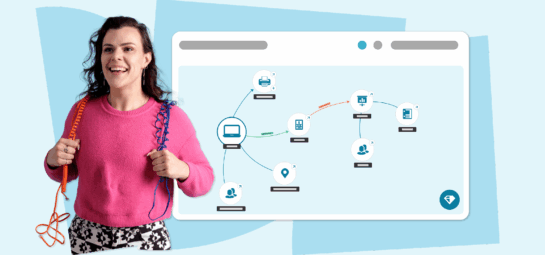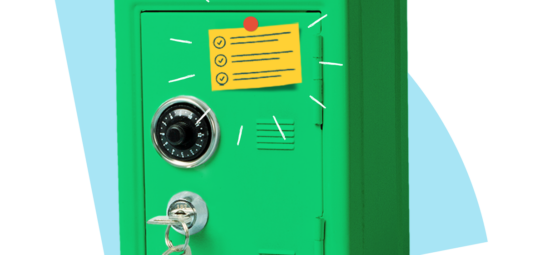Driving cross-departmental collaboration through Enterprise Service Management

Cross-departmental collaboration isn’t just a buzzword – it’s a must for service departments. Solid collaboration between departments like IT, HR, and Facilities helps solve problems faster, improves communication, and delivers seamless service experiences across the organization.
But true collaboration requires more than good intentions. It takes the right mindset, processes, and – crucially – the right tools. That’s where Enterprise Service Management (ESM) comes in.
ESM goes beyond traditional IT Service Management by applying shared workflows, centralized ticketing, and automation across multiple service departments. The result? Silos are broken down, operational efficiency improves, and a culture of collaboration takes root across the company.
Let’s explore how to achieve effective cross-departmental collaboration with ESM – and why it’s a game-changer for modern organizations.
True collaboration requires more than good intentions. It takes the right mindset, processes, and – crucially – the right tools.
From cooperation to collaboration: what’s the difference?
Cooperation is when departments agree to work alongside each other: “I’ll do my part; you do yours.”
Collaboration goes deeper than just working together. It’s about shared ownership, open communication, and working together toward a common goal. True cross-departmental collaboration enables teams to align their strengths, share responsibilities, and jointly solve problems. It allows organizations to make the most of their resources by assigning the right people to the right tasks, ultimately driving better outcomes.
The result? Improved efficiency, stronger work relationships, and a culture of collaboration that fosters innovation across departments.
So why do some organizations hesitate to embrace cross-departmental collaboration?
Why departments resist cross-departmental collaboration
According to Harvard Business Review, teams often resist cross-departmental collaboration because of:
- Loss of group identity: identity provides groups with a center of gravity and meaning within an organization.
- Loss of control over decisions and outcomes: groups feel that they must be able to act autonomously to effect meaningful change.
- Loss of legitimacy within the organization: a group’s legitimacy develops when that group is perceived by others as fitting, acceptable, and valuable within the organization.
These fears are rooted in territorial thinking – the belief that each team must protect its domain to retain value and autonomy. In many cases, this results in an unintended consequence – individuals and departments become focused on achieving individual goals at the expense of broader organizational goals.
ESM addresses these concerns by reaffirming each department’s unique role while creating shared processes that respect autonomy but improve collaboration and performance
Why cross-departmental collaboration matters
Cross-departmental collaboration delivers real business benefits:
- Faster issue resolution through shared workflows
- Improved communication and fewer silos
- Increased employee satisfaction through seamless service delivery
- Stronger innovation by combining diverse skills and viewpoints
- Higher productivity through aligned processes and fewer duplicated efforts
How Enterprise Service Management enables cross-departmental collaboration
Enterprise Service Management (ESM) is the foundation for modern cross-departmental collaboration. It transforms how teams work together by applying service management principles beyond IT.
Here’s how:
1. Breaking down silos with shared workflows
In many organizations, departments operate in silos, with their own processes, tools, and data. ESM introduces shared workflows that connect IT, HR, Facilities, Finance, and more – so they can collaborate on resolving tickets and delivering services together.
For example, onboarding a new employee involves multiple departments. With ESM, IT, HR, and Facilities can align on a single workflow that automates tasks like provisioning accounts, issuing badges, and assigning desks – reducing delays and confusion.
2. Centralized ticketing and self-service portals
A centralized ticketing system means end users don’t have to guess where to go for help. Whether it's a laptop issue, payroll question, or facilities request, users can submit all service needs through a single point of contact (SPOC).
The result?
- Consistent service delivery
- Better visibility across departments
- Fewer duplicate tickets
- Data-driven insights on cross-departmental performance
ESM introduces shared workflows that connect IT, HR, Facilities, Finance, and more.
3. Automation and smart routing
Automation is a key ESM software feature that reduces manual handoffs and speeds up ticket resolution. For instance, a facilities request submitted in the self-service portal can be automatically routed to the correct team, escalated when needed, and resolved faster.
By minimizing back-and-forth and human error, ESM empowers team members to focus on strategic initiatives – not repetitive admin work.
4. Encouraging a culture of collaboration
When departments have shared tools, goals, and performance metrics, they start working together toward a common goal. ESM helps foster a culture of collaboration by making outcomes transparent and shared – not siloed.
This culture shift leads to:
- Greater alignment with company-wide goals
- Empowered teams leading cross-functional projects
- Open communication between stakeholders
Overcoming resistance to cross-departmental collaboration
Still facing resistance? Start by answering the WIIFM: “What’s in it for me?”
For departments:
- Reinforce their identity by spotlighting their critical expertise
- Reaffirm their legitimacy in key decisions
- Reassert control by defining where they retain autonomy
For example, the IT team remains the expert in tech issue resolution, while Facilities continues to own workspace logistics – ESM just ensures collaboration tools and processes tie their efforts together.
For individuals:
- Highlight how collaboration improves outcomes
- Help them visualize mutual benefits through shared projects
- Reconnect them with their purpose and contribution to a larger mission
Mapping collaboration opportunities with ESM
Not sure where to start? Use these project management tools to uncover cross-departmental collaboration opportunities:
- Customer journey maps: Visualize how your end users interact with multiple departments to understand pain points across internal services
- Value stream maps: Identify where workflows cross departmental boundaries
These maps reveal where cross-functional teams can align to reduce friction and enhance the user experience.
5 tips to drive effective cross-departmental collaboration
Want to see immediate benefits of cross-departmental collaboration? Apply these five principles:
- Be inclusive: Invite all relevant departments from the beginning
- Act with urgency: Keep momentum with regular check-ins and quick wins
- Celebrate success: Publicly highlight wins and collaboration stories
- Iterate: Improve workflows continuously, not all at once
- Use the right tools: Invest in ESM software that enables true collaboration
The role of ESM software in enabling cross-departmental collaboration
ESM software like TOPdesk's makes cross-departmental collaboration a reality. It enables:
- A shared vision for service delivery across departments
- Automation of repetitive tasks
- Self-service portals that reduce manual intervention
- Real-time reporting to improve transparency and accountability
- Tailored workflows for each cross-functional team
TOPdesk’s ESM software unites departments like IT, HR, Facilities, and more under one intuitive system. With shared workflows, centralized ticketing, and a single point of contact for all service requests, ESM makes it easy for departments working together to support one another and respond more efficiently.
North Lincolnshire Council experienced this first-hand:
We were initially looking for a tool for IT and HR. But then we realised TOPdesk was a genuine Shared Service tool and we’d be able to include many more functions.
By unifying service management processes across the organization, ESM helps departments move from isolated functions to collaborative partners.
Discover TOPdesk's ESM software
Cross-departmental collaboration is the future of service management
As digital transformation accelerates, departments can no longer afford to work in silos. Effective cross-departmental collaboration is critical to solving problems faster, delighting employees, and adapting to change.
Enterprise Service Management provides the structure, tools, and mindset needed to foster that collaboration. When departments share goals, workflows, and success metrics, they become more than service providers – they become strategic enablers working together toward a shared vision.
Start fostering a culture of collaboration today. Break down silos, empower teams, and watch your service delivery reach new heights.
Want to learn more about ESM and how to start truly collaborating with other service departments? Download our ESM e-book and start benefiting from working together.
Inspire others, share this blog



